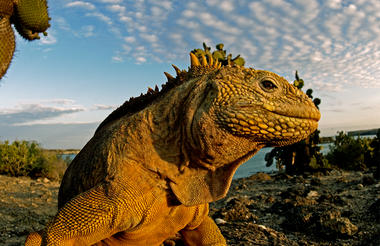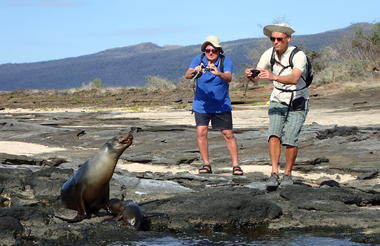Baltra Airport and Santa Cruz Island
After landing at Baltra Airport, we drive to the Itabaca Channel to take a ferry across to Santa Cruz Island. A 30-minute bus ride takes us up to the fascinating, more humid Highlands of the island where we’ll learn about its unique ecosystems and biodiversity. Lunch will be served at a local restaurant.
Santa Cruz Island’s Highlands and Puerto Ayora
After lunch, we drive to a nearby reserve that is one of the best places in the archipelago to see giant tortoises in their natural habitat. The tortoises are easy to spot, lumbering around, munching on grass and leaves, and wallowing in small pools. There are several lava tunnels to explore in the reserve, too. A short bus ride takes us down to Puerto Ayora to board the Isabela II.



Note: Please dress in comfortable shoes and clothes, bring a small backpack with any medicine you might be taken, sunblock, insect repellent, and anything you need during the excursion. You’ll go onboard Yacht Isabela II at the end of the day.
Puerto Egas (Santiago Island)
Following a wet landing on the black, sandy beach, our trail takes us to enjoy close-up encounters with recently reintroduced land iguanas, plus land and marine birds amid a landscape of tuff-stone layers, jagged rocks, and lava flows. At low tide, marine iguanas graze upon the algae beds. We can also observe a colony of fur seals, usually dozing in the shade of some rocks.
Chinese Hat Islet
This islet, formed only relatively recently, makes a wonderful afternoon visit as we explore the wildlife along its 1,312 ft long (400 m long) trail, which begins at a crescent-shaped, white sandy beach. The cove offers excellent swimming and snorkeling opportunities amid white-tipped reef sharks and Galapagos penguins.



Prince Philip’s Steps (Genovesa Island)
The day kicks off with a panga ride along the cliffs of “Bird Island” as Genovesa is affectionately nicknamed, followed by a landing at a steep staircase that connects us with a flat plateau. From here, the trail winds its way through large colonies of Nazca boobies, red-footed boobies, great frigatebirds, and storm petrels. With luck, we’ll be able to spot the short-eared owl. Those who do not wish to disembark can enjoy a longer panga (inflatable dinghy) ride along the cliffs, weather conditions permitting. Snorkeling and kayaking activities are available.
Darwin Bay (Genovesa Island)
We land after lunch at the beautiful white beach of Darwin Bay. Here we walk amid literally hundreds of birds, most of which are frigatebirds, red-footed and Nazca boobies, as well as gulls, herons, finches, and mockingbirds.



Santa Fe Island
We take the dinghy over to this idyllic sandy-white beach populated by colonies of sea lions. Galapagos hawks are often easily observed, perched atop salt bushes. The Santa Fe land iguana may be spotted during our exploration. Following the walk, we can snorkel and swim along a natural wave barrier or ride the glass-bottom boat.
Punta Carrion (Santa Cruz Island)
In the afternoon, we make our way around to the northern coast of Santa Cruz Island to the eastern mouth of the Itabaca Channel. Boarding our dinghies, we explore this rocky coastline’s interesting formations, plant life, and wildlife, before enjoying the marine world, either with a mask and snorkel or aboard our glass-bottom boat. If we are lucky, we will come across playful sea lions, dozens of reef fish — different types of puffers, surgeonfish, angelfish, groupers, hogfish, hawkfish, parrotfish, blenny, etc. — and hopefully catch a glimpse of white-tipped reef sharks.



Baltra Island
Our journey ends at Baltra Island where we transfer to the airport to take the flight back to the mainland.




